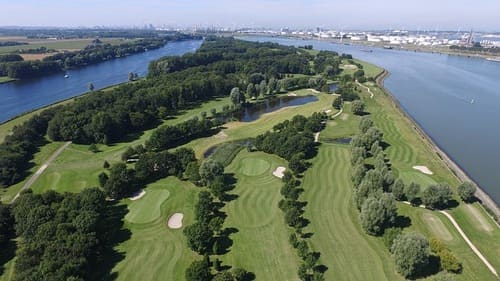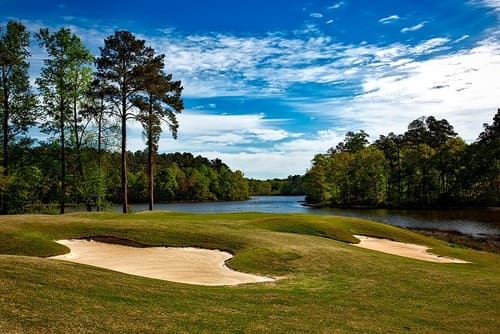Determining the size of a golf course is a critical step in its development process. Several factors need to be carefully considered to ensure the optimal size for a golf course. One of the primary considerations is the availability of land. The golf course should be able to fit comfortably within the available space without feeling crowded or constrained. Additionally, the land should have enough room for the fairways, greens, and hazards to create a challenging yet enjoyable playing experience for golfers. But how many acres are need for a golf course?
Factors to Consider When Determining Golf Course Size
Another factor to consider when determining golf course size is the target market. It is essential to understand the demographics and preferences of the potential golfers who will frequent the course. For instance, if the golf course aims to attract beginners or families, it might be more appropriate to have a smaller, shorter course. This makes it less intimidating and time-consuming to play. On the other hand, if the target audience is experienced players, a larger and more challenging course might be more suitable to cater to their skills and expectations. By considering the target market, the size of the golf course can be designed to meet the specific needs and desires of the intended golfing community.
10 Most Popular US Golf Courses
| Golf Course | Location | Approx. Acres |
|---|---|---|
| Augusta National Golf Club | Augusta, Georgia | 365 |
| Pebble Beach Golf Links | Pebble Beach, California | 100 |
| Pinehurst No. 2 | Pinehurst, North Carolina | 380 |
| Bethpage Black | Farmingdale, New York | 292 |
| Merion Golf Club | Ardmore, Pennsylvania | 126 |
| Shinnecock Hills Golf Club | Southampton, New York | 290 |
| Whistling Straits | Kohler, Wisconsin | 560 |
| Oakmont Country Club | Oakmont, Pennsylvania | 240 |
| Winged Foot Golf Club | Mamaroneck, New York | 250 |
| Torrey Pines Golf Course | San Diego, California | 430 |
Understanding the Relationship Between Golf Course Size and Layout
Golf course size and layout are intricately connected, with each factor influencing the other to create a harmonious playing experience. The size of a golf course refers to the total acreage it occupies, while the layout refers to the arrangement of holes, hazards, and other elements within the course.
When determining the size of a golf course, various factors come into play. The first consideration is the available land, as the size of the course must be compatible with the available space. Additionally, the desired number of holes also affects the size, as a standard golf course typically consists of 18 holes. The topography of the land, such as hills or water bodies, also plays a role in determining the overall size and layout. These factors all contribute to creating a challenging yet enjoyable course for players of all skill levels.
The Role of Land Topography in Determining Golf Course Size
Golf course design heavily relies on the natural topography of the land. The role of land topography in determining golf course size is two-fold. Firstly, the available land and its features decide the overall size and layout of the course. For instance, if the land is hilly or has a lot of water bodies, it may require more acreage to accommodate the fairways, greens, and hazards. On the other hand, if the land is relatively flat, the course may be designed within a smaller area. Secondly, the topography influences the strategic placement of various features like bunkers, trees, and water hazards. The contours and slopes of the land can be used creatively to enhance the difficulty and interest of the course, making it more enjoyable for players while also providing them with a fair but challenging experience.

Another significant consideration in golf course design is the integration of the course with the surrounding landscape. The land’s topography plays a crucial role in how well the golf course blends with its natural environment. For instance, a course situated in a valley may utilize the surrounding hills to create a picturesque setting. A layout with fairways and greens nestled between the slopes fits this bill. Conversely, a course built on an elevated piece of land might leverage the scenic views by utilizing the natural ridges and viewpoints. By harmonizing the course with the land’s topography, golf course architects can create visually stunning and environmentally sustainable layouts that enhance the overall playing experience.
Environmental Considerations for Golf Course Development
Golf course development is a complex undertaking that requires careful consideration of environmental factors. One of the key considerations is the impact on existing ecosystems and wildlife habitats. When planning a golf course, it is important to assess the potential effects on local flora and fauna, and to incorporate measures to minimize disruption. This may involve maintaining natural drainage patterns, preserving existing trees and vegetation, and creating buffer zones to protect sensitive areas.
Another environmental consideration is the use of water resources. Golf courses require significant amounts of water for irrigation, and this can put strain on local water supplies. Such as sustainable water management practices, such as using recycled water or implementing efficient irrigation systems. This can help to reduce water consumption and minimize the impact on the surrounding environment. Additionally, efforts should be made to prevent the contamination of water sources through careful management of chemical use and fertilization practices. These factors create courses that coexist harmoniously with their surroundings and minimize negative impacts on the environment. Incorporating these environmental considerations into golf course development is a good idea.
Designing Golf Courses to Optimize Player Experience
Designing a golf course that optimizes player experience is a paramount consideration for course developers. The layout, design, and overall atmosphere of the course all contribute to the enjoyment and satisfaction of players. One crucial aspect of optimizing the player experience is the strategic placement of hazards, such as bunkers and water hazards. These features not only challenge players’ skills but also add visual interest and excitement to the course. Thoughtful design that considers the ranges of player abilities can also enhance the experience, as it allows players of different skill levels to enjoy the course without feeling overwhelmed or unchallenged.
In addition to the layout and challenges, the overall aesthetics of the golf course play a significant role in optimizing the player experience. The use of well-manicured fairways, beautiful landscaping, and inspiring views can greatly enhance the overall ambiance. A visually appealing course provides a more enjoyable playing environment. This also creates a lasting impression on the players. Furthermore, the proper placement of amenities, such as conveniently located restrooms, water stations, and food and beverage facilities, can greatly contribute to the overall comfort and satisfaction of the players. By designing a golf course that considers these factors, developers can create a memorable and enjoyable experience for all golfers.

The Influence of Golf Course Size on Maintenance and Operation Costs
When it comes to the maintenance and operation costs associated with golf courses, size plays a significant role. Larger golf courses typically require more resources and manpower to keep them in optimal condition. In general, the larger the course, the higher the maintenance costs. This is because larger courses have more playing surfaces, including fairways, greens, and rough areas, which all need to be maintained to a high standard. Additionally, a larger course often means more trees, shrubs, and landscaping, which require regular care and attention. The costs of equipment, such as mowers and irrigation systems, are also influenced by the size of the course, as larger areas require more extensive and capable machinery. Overall, the size of a golf course directly impacts the maintenance and operation costs, requiring careful consideration and planning by course developers and managers.
However, it is important to note that smaller courses can also incur significant maintenance costs. They may require fewer resources and manpower compared to larger courses. However, they still need to be maintained to meet the expectations of players. Smaller courses may have limited space for fairways and greens, which means that the available area needs to be well-manicured and kept in top condition. Moreover, the design and layout of the course can also influence maintenance costs. For example, a course with intricate bunkers or water features may require additional resources to maintain these aspects. Ultimately, the size of a golf course, whether large or small, has a direct impact on the maintenance and operation costs, and careful planning and budgeting are crucial to strike a balance between cost-efficiency and delivering an excellent golfing experience.
Balancing Aesthetics and Functionality in Golf Course Design
Golf course design involves striking a delicate balance between aesthetics and functionality. While a visually stunning course with captivating features can enhance the overall golfing experience, it is essential to ensure that the design elements do not compromise the functionality and playability of the course.
Aesthetics play a crucial role in attracting golfers and creating a memorable experience. Incorporating picturesque landscapes, strategically placed water features, and well-manicured greens can contribute to the overall beauty of the course. The use of natural elements, such as trees and vegetation, can enhance the visual appeal. Whilst also provide a pleasant and calming environment for golfers. However, it is crucial to maintain a balance between aesthetics and functionality to avoid creating obstacles or distractions that could hinder the game.

The Impact of Golf Course Size on Playability and Difficulty Level
Golf course size plays a significant role in determining the overall playability and difficulty level of the course. Larger courses tend to offer more space for the layout and design. This allows for a greater variety of holes and challenges, which is an architects dream. With more room to work with, course designers can incorporate strategically placed hazards, bunkers, and water features that require skilled shot-making and strategic decision-making from the players. This adds an element of difficulty and excitement to the game. Thus making it more engaging for golfers of all skill levels.
On the other hand, smaller golf courses may have limited space to work with, resulting in a more compact layout. While this may translate into a shorter overall course length, it does not necessarily mean that the playability or difficulty level is compromised. In fact, smaller courses often compensate for their size by incorporating a clever design that maximizes the use of available land. By strategically placing hazards and designing challenging greens, smaller courses can still provide golfers with an enjoyable and testing experience. Additionally, the relatively shorter length of these courses may attract beginners or golfers with limited time, offering them a chance to play a round of golf without feeling overwhelmed by a larger, more daunting course.
Planning for Future Expansion and Adaptation of Golf Course Size
One of the key considerations in designing a golf course is planning for future expansion and adaptation. Golf courses need to be able to meet the evolving needs and preferences of players, as well as keeping up with the advancements in golf technology and equipment. Therefore, it is essential to factor in the potential for future expansion when determining the size of a golf course.
Planning for future expansion involves carefully assessing the available land and considering the possible amenities or features that may be added to enhance the golfing experience. This could include adding additional holes, practice facilities, or even reconfiguring the layout to accommodate new trends in the sport. By taking a proactive approach to designing the golf course, developers can ensure that there is enough space and flexibility to make adjustments in the future without compromising the overall aesthetics and functionality of the course.

Case Studies: Examples of Different Golf Course Sizes and Their Success Stories
Golf courses come in various sizes, each with its own unique attributes and advantages. One such example is the Hillview Golf Course, a small 9-hole course nestled in the serene countryside. Despite its limited footprint, Hillview has managed to attract a loyal following of golf enthusiasts who appreciate its quaint atmosphere and challenging layout. The small size allows for quick play, making it an ideal choice for golfers seeking a quick round on a busy day. Moreover, its intimate setting encourages a sense of camaraderie amongst players, fostering a friendly and welcoming community.
Contrastingly, the North Ridge Golf Club boasts an expansive 18-hole layout that sprawls over rolling hills and offers breathtaking views of the surrounding landscape. The large size of the course enables dynamic hole designs, with each one presenting a unique set of challenges. Golfers who visit North Ridge relish in the opportunity to test their skills, strategizing their shots amidst the vast greens and fairways. Additionally, the ample space allows for a diverse range of amenities, including practice facilities, a clubhouse, and even accommodation options. These offerings contribute to the overall appeal of North Ridge, attracting golfers from far and wide to experience its grandeur.
FAQs
What factors should be considered when determining the size of a golf course?
Factors such as available land, budget, target market, and desired level of difficulty should be considered when determining the size of a golf course.
How does the size of a golf course affect its layout?
The size of a golf course can determine the number of holes and their arrangement, as well as the overall flow and strategic design of the course.
How does land topography play a role in determining the size of a golf course?
Land topography can influence the layout and size of a golf course. Flat or hilly terrain may require different acreage and design considerations.
What environmental considerations should be taken into account when developing a golf course?
Environmental considerations can include preserving natural habitats, managing water resources, and implementing sustainable practices in golf course development.
How can golf courses be designed to optimize player experience?
Golf courses can be designed to provide a variety of challenges, strategic shot options, and aesthetic appeal to enhance the overall player experience.
How does the size of a golf course affect maintenance and operation costs?
Larger golf courses generally require more resources and manpower for maintenance, resulting in higher operation costs compared to smaller courses.
How can golf course design balance aesthetics and functionality?
Golf course design should strive to create visually pleasing landscapes while still maintaining functional and playable areas for golfers.
How does the size of a golf course impact its playability and difficulty level?
The size of a golf course can impact the length of holes, the number and placement of hazards, and the overall challenge and difficulty level for players.
How can golf courses plan for future expansion and adaptation of their size?
Golf courses can plan for future expansion by securing additional land, incorporating flexible design elements, and considering potential changes in player demographics.





